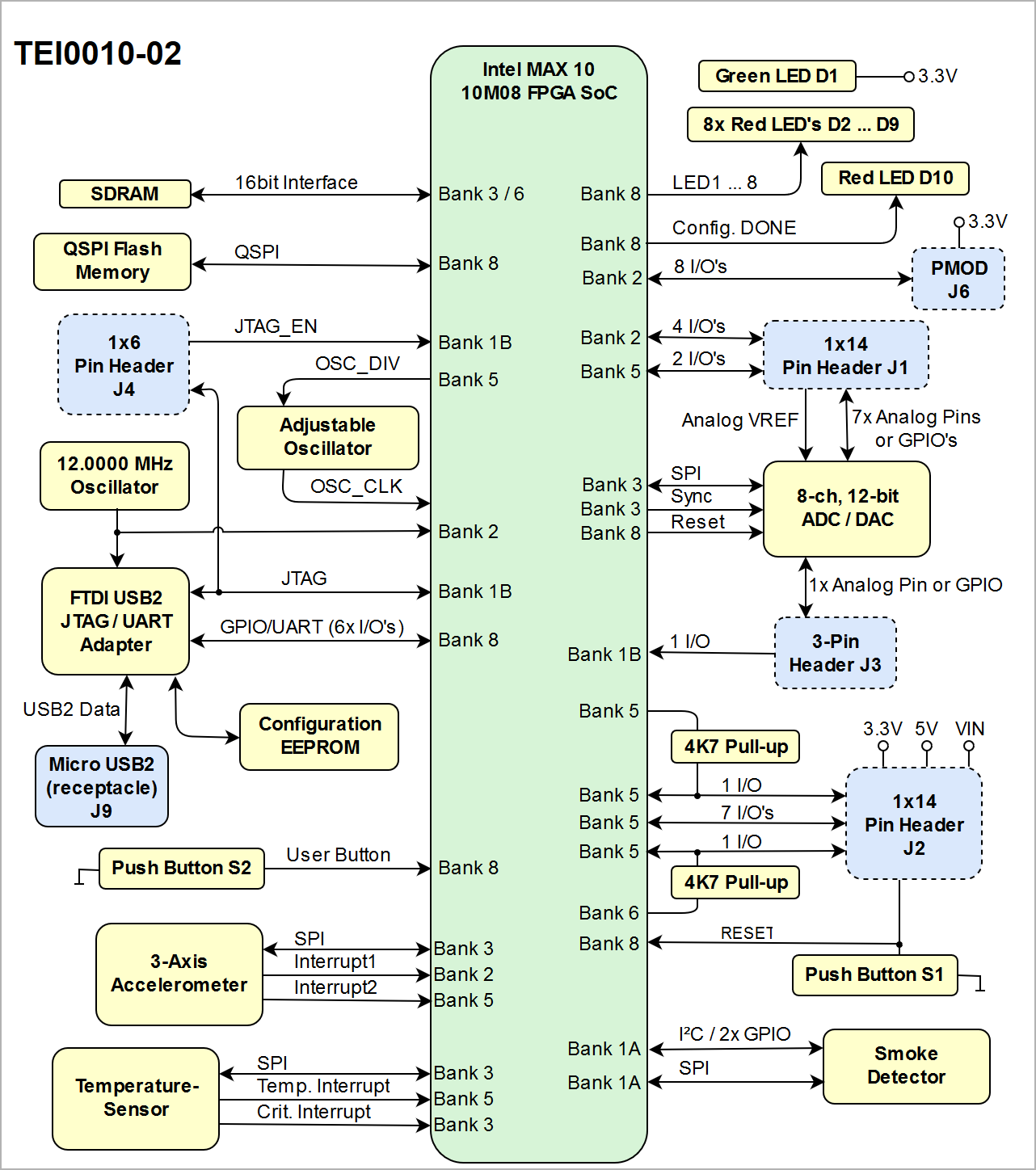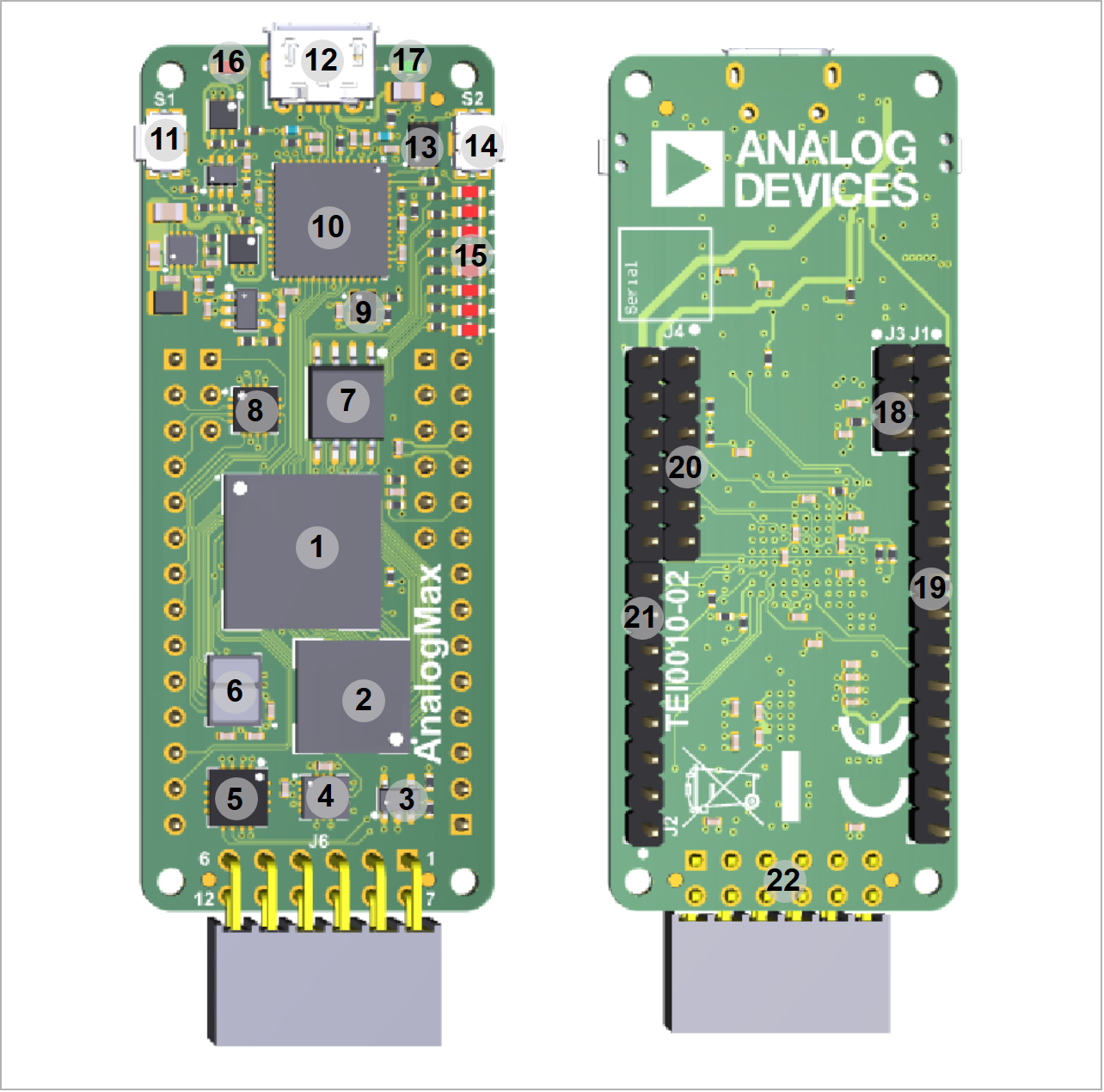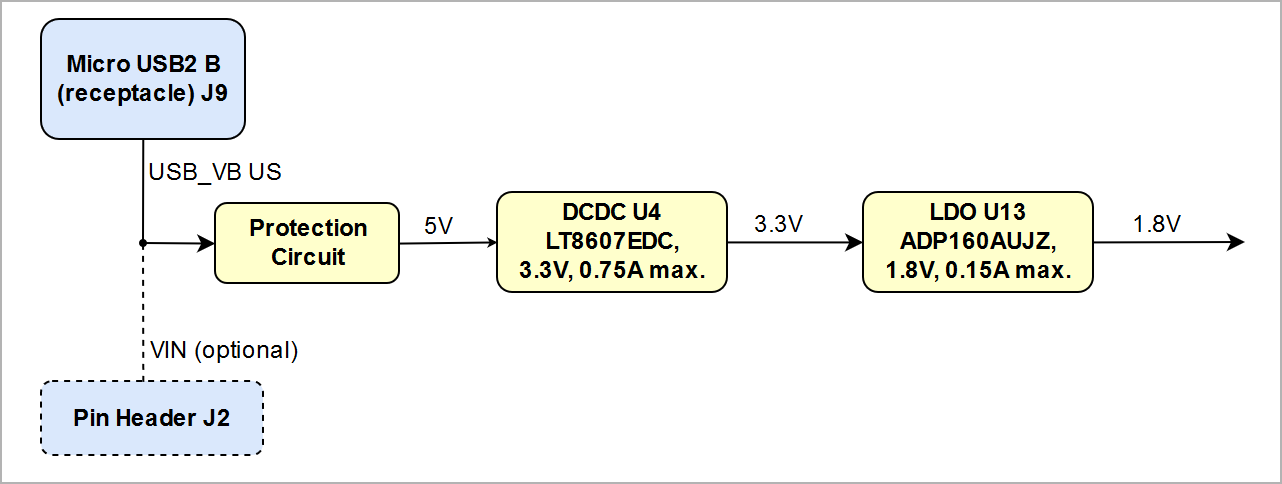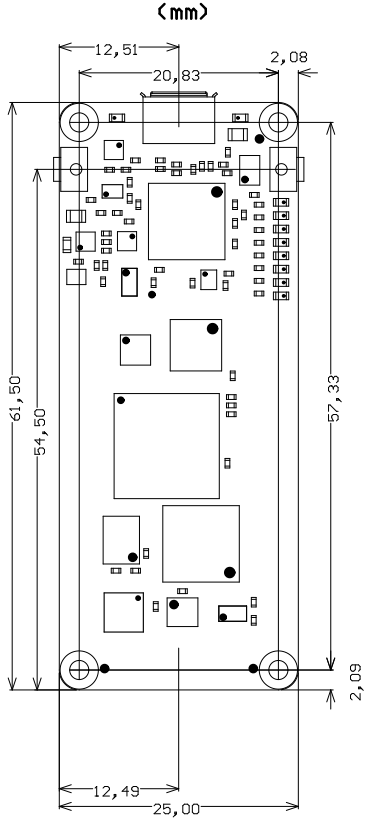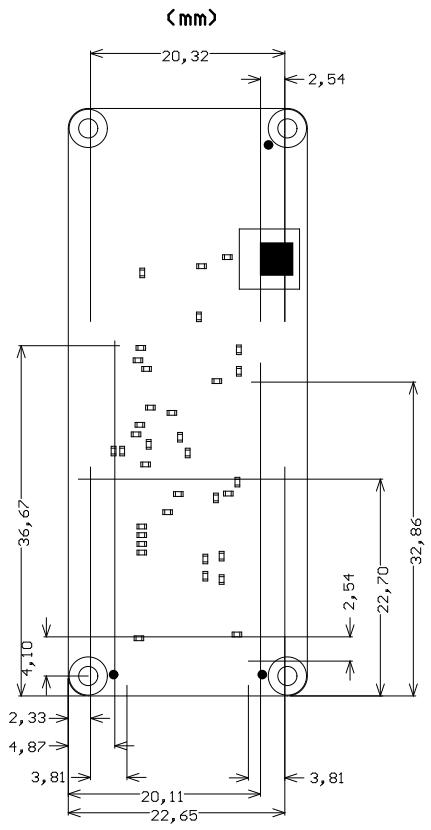Template Revision 2.2 TRM Name always "TE Series Name" +TRM, for example "TE0720 TRM" |
<!-- tables have all same width (web max 1200px and pdf full page(640px), flexible width or fix width on menu for single column can be used as before) -->
<style>
.wrapped{
width: 100% !important;
max-width: 1200px !important;
}
</style> |
----------------------------------------------------------------------- |
Note for Download Link of the Scroll ignore macro: |
Table of Contents 
|
Overview
The Trenz Electronic TEI0010 AnalogMax is a low cost small-sized FPGA module integrating an Intel MAX 10 FPGA SoC, 8 MByte serial memory for configuration and operation and 8 MByte SDRAM. The board is equipped with several sensors for analog values like a 3-axis accelerometer, temperature sensor, smoke detector and a 8-channel 12bit ADC/DAC.
Refer to http://trenz.org/analogmax-info for the current online version of this manual and other available documentation.
Key Features
Notes : - List of key features of the PCB
|
Intel MAX 10 10M08 FPGA SoC
- 8 MByte SDRAM
8 MByte QSPI Flash memory
- Onboard oscillator with 3 selectable frequencies
- Analog Devices ADXL362 MEMS 3-axis accelerometer
- Analog Devices ADT7320 temperature sensor
- Analog Devices ADPD188BI smoke detector
- Analog Devices AD5592R ADC/DAC
- JTAG and UART over Micro USB2 connector
- 1x6 pin header for JTAG access to FPGA SoC
- 1x PMOD header providing 8 I/O
2x 14-pin headers (2,54 mm pitch) providing I/O with 7 analog inputs as alternative function
- 1x 3-pin header providing 2 analog inputs or 1 digital I/O
8x user LEDs
- 1x user push button
- 5.0V single power supply with on-board voltage regulators
- Size: 61.5 x 25 mm
Block Diagram
Main Components
Notes : - Picture of the PCB (top and bottom side) with labels of important components
- Add List below
|
- Intel MAX 10 10M08 FPGA SoC, U1
- 8 Mbyte SDRAM 166MHz, U2
- LT LTC1799 oscillator, U10
- Analog Devices ADXL362BCCZ MEMS 3-axis accelerometer, U11
- Analog Devices ADT7320UCPZ temperature sensor, U8
- Analog Devices ADPD188BI smoke detector, U14
- Winbond W74M64FV QSPI Flash memory, U5
- Analog Devices AD5592RBCPZ ADC/DAC, U12
- 12.0000 MHz MEMS oscillator, U7
- FTDI USB2 to JTAG/UART adapter, U3
- Push button (reset), S1
- Micro USB2 B socket (receptacle), J9
- Configuration EEPROM for FTDI chip, U9
- Push button (user), S2
- 8x red user LEDs, D2 ... D9
- Red LED (Conf. DONE), D10
- Green LED (indicating 3.3V supply voltage), D1
- 3-pin header (2.54mm pitch), J3
- 1x14 pin header (2.54mm pitch), J1
- 1x6 pin header (2.54mm pitch), J4
- 1x14 pin header (2.54mm pitch), J2
- 2x6 Pmod connector, J6
Initial Delivery State

Storage device name | Content | Notes |
|---|
| Quad SPI Flash, U5 | Empty | - | | FTDI chip configuration EEPROM, U9 | Programmed | Arrow Blaster identification |
|
Control Signals
- Overview of Boot Mode, Reset, Enables,
|
To get started with TEI0010 board, some basic signals are essential and are described in the following table:

Control signal | Switch / Button / LED / Pin | Signal Schematic Names | Connected to | Functionality | Notes |
|---|
| MAX10 FPGA U1 JTAGEN | header J4, pin 2 | JTAGEN | MAX10 FPGA U1, bank 1B, pin E5 | high or floating: MAX 10 JTAG enabled,
low: MAX 10 JTAG disabled | switch the JTAG pins to user I/O if pin is driven low | | MAX10 FPGA U1 Reset | header J2, pin 10 | RESET | MAX10 FPGA U1, bank 8, pin E7 | low active reset line | also connected to Reset push button S1 | | Supply voltage indicator | Green LED D1 | 3.3V | DC-DC converter U4 | indicating 3.3V voltage level | - | | Configuration DONE indicator | Red LED D10 | CONF_DONE | MAX10 FPGA U1, bank 8, pin C5 | indicating FPGA configuration completed | OFF: configuration completed, ON: FPGA not configured | | Reset Push button | S1 | RESET | MAX10 FPGA U1, bank 8, pin E7 | low active logic | - | | User Push button | S2 | USER_BTN | MAX10 FPGA U1, bank 8, pin E6 | low active logic | available to user |
|
Boot Process
The FPGA configuration for Intel MAX 10 FPGAs can be stored through JTAG interface (using a POF file) on the FPGA itself since the Intel MAX 10 FPGA offers non-volatile memory on chip. The FPGA configuration is loaded from the MAX10 non-volatile CFM memory when the board is powered up.
To configure the FPGA directly, the JTAG interface can be used to configure the FPGA SRAM (using a SOF file), then the configuration is lost after power off.
Signals, Interfaces and Pins
Notes : - For carrier or stand-alone boards use subsection for every connector typ (add designator on description, not on the subsection title), for example:
- For modules which needs carrier us only classes and refer to B2B connector if more than one is used, for example
|
I/Os on Pin Headers and Connectors
I/O signals of the FPGA SoC's I/O banks connected to the board's pin headers and connectors:

| Bank | Connector Designator | I/O Signal Count | Bank Voltage | Notes |
|---|
| 2 | J1 | 4 I/O's | 3.3V | - | | J6 | 8 I/O's | Pmod connector | | 5 | J1 | 2 I/O's | 3.3V | - | | J2 | 9 I/O's | 2 I/O's of bank 5 can be pulled-up to 3.3V (4K7 resistors) | | 1B | J4 | JTAG interface and 'JTAGEN' signal (5 I/O's) | 3.3V | JTAG enable signal (JTAGEN) on pin J4-2, switch between user I/O pins and JTAG pin functions | | J3 | 1 I/O | - |
|
JTAG Interface
Primary JTAG access to the FPGA SoC device U1 is provided through Micro USB2 B connector J9. The JTAG interface is created by the FTDI FT2232H USB2 to JTAG/UART adapter IC U3.
Optionally 1x6 male pin header J4 can be fitted on board for access to the JTAG interface between FTDI and FPGA on board. The pin assignment of header J4 is shown on table below:

| JTAG Signal | Pin on Header J4 | Note |
|---|
| TCK | 3 | - | | TDI | 5 | - | | TDO | 4 | - | | TMS | 6 | - | | JTAGEN | 2 | leave open for normal operation |
|
Micro-USB2 Connector
The Micro-USB2 connector J9 provides an interface to access the UART and JTAG functions via FTDI FT2232 chip. The use of this feature requires that USB driver is installed on your host PC.
FPGA I/O banks
Table below contains the signals and interfaces of the FPGA banks connected to pins and peripherals of the board:

| Bank | I/O's Count | Connected to | Notes |
|---|
| 2 | 4 | 1x14 pin header, J1 | user GPIO's | | 8 | Pmod connector, J6 | user GPIO's | | 1 | clock oscillator, U7 | 12.0000 MHz reference clock input | | 1 | clock oscillator, U10 | reference clock input from optional oscillator U10 | | 1 | accelerometer IC, U11 | interrupt 1 line of Analog Devices MEMS accelerometer | | 5 | 9 | 1x14 pin header, J2 | 2 I/O's (D11, D12) of bank 5 can be pulled-up to 3.3V (4K7 resistors) with 1 I/O (D12_R) of same bank and 1 I/O (D11_R) of bank 6 | | 1 | accelerometer IC, U11 | interrupt 2 line of Analog Devices MEMS accelerometer | | 1 | clock oscillator, U10 | control line to select adjustable oscillator output frequency | | 1 | temperature sensor IC, U8 | interrupt line of temperature thresholds | | 6 | 18 | SDRAM, U2 | 16bit SDRAM memory interface | | 3 | 22 | SDRAM, U2 | 16bit SDRAM memory interface | | 3 | SPI interface connected to IC U8, U11, U12 | SPI interface (MISO, MOSI, MCLK) for temperature sensor U8, 3-axis accelerometer U11 and ADC/DAC U12 | | 1 | temperature sensor IC, U8 | chip-select line for SPI interface | | 1 | accelerometer IC, U11 | chip-select line for SPI interface | | 1 | ADC/DAC IC , U12 | data input frame synchronization line of ACD/DAC IC (active low control input) | | 1 | temperature sensor IC, U8 | interrupt line of critical temperature | | 1A | 8 | smoke detector IC, U14 | SPI, I²C interface and GPIO's of smoke detector IC U14 | | 1B | 1 | pin header J3 | 1 x digital I/O | | 5 | FTDI FT2232H IC U3 (4 JTAG I/O's) and pin header J4 (5 I/O's) | 4 I/O's JTAG interface and 1x 'JTAGEN' signal to switch the JTAG pins to user I/O if drive this pin to GND | | 8 | 8 | LEDs D2 ... D9 | Red user LEDs | | 6 | QSPI Flash memory, U5 | 6 pins Quad SPI interface (2 pins have are shared function) | | 6 | FTDI FT2232H JTAG/UART adapter, U3 | 6 pins configurable as GPIO or UART | | 1 | Red LED, D10 | Configuration DONE Led (ON when configuration in progress, OFF when configuration is done) | | 1 | User button S2 | user configurable | | 1 | Reset button S1 and pin J2-10 | low active reset line for FPGA reconfiguration |
|
On-board Peripherals
Notes : - add subsection for every component which is important for design, for example:
- Ethernet PHY
- USB PHY
- Programmable Clock Generator
- Oscillators
- eMMCs
- RTC
- FTDI
- ...
- DIP-Switches
- Buttons
- LEDs
|
Serial Configuration Memory
On-board serial configuration memory (U5) is provided by Winbond W74M64FVSSIQ with 64 MBit (8 MByte) storage capacity. This non volatile memory is used to store initial FPGA configuration via JTAG interface. The memory is connected to FPGA bank 1 via SPI interface.

| Serial Memory U5 Pin | Signal Schematic Name | Connected to | Notes |
|---|
| Pin 1, CS | F_CS | FPGA bank 8, pin B3
| chip select | | Pin 6, CLK | F_CLK | FPGA bank 8, pin A3 | clock | | Pin 5, SI/IO0 | F_DI | FPGA bank 8, pin A2 | data in / out | | Pin 7, HOLD/IO3 | NSTATUS | FPGA bank 8, pin C4 | data in / out (configuration dual-purpose pin of FPGA) | | Pin 3, WP/IO2 | DEVCLRN | FPGA bank 8, pin B9 | data in / out (configuration dual-purpose pin of FPGA) | | Pin 2, SO/IO1 | F_DO | FPGA bank 8, pin B2 | data in / out |
|
SDRAM
The FPGA module is equipped with a Winbond W9864G6JT 64 MBit (8 MByte) SDRAM chip U2 in standard configuration, variants with 256 Mbit (32 MByte) memory density are also available. The SDRAM chip is connected to the FPGA bank 3 and 6 via 16-bit memory interface with 166MHz clock frequency and CL3 CAS latency.

| SDRAM I/O Signals | Signal Schematic Name | Connected to | Notes |
|---|
| Address inputs | A0 ... A13 | bank 3 | - | Bank address inputs
| BA0 / BA1 | bank 3 | - | | Data input/output | DQ0 ... DQ15 | bank 6 | - | | Data mask | DQM0 ... DQM1 | bank 6 | - | | Clock | CLK | bank 3 |
| | Control Signals | CS | bank 3 | Chip select | CKE | bank 3 | Clock enable | RAS | bank 3 | Row Address Strobe | CAS | bank 3 | Column Address Strobe | | WE | bank 3 | Write Enable |
|
FTDI FT2232H Chip
The FTDI chip U3 converts signals from USB2 to a variety of standard serial and parallel interfaces. Refer to the FTDI data sheet to get information about the capacity of the FT2232H chip.
The configuration of FTDI FT2232H chip is pre-programmed on the EEPROM U9.
Channel A of the FTDI chip is configured as JTAG interface (MPSSE) connected to the bank 1B of MAX10 FPGA U1.
Channel B is routed via 6 I/O's to bank 8 of MAX10 FPGA U1 and are usable as UART, GPIO, SPI or bit-banged I2C.

| FTDI Chip U3 Pin | Signal Schematic Name | Connected to | Notes |
|---|
| Pin 12, ADBUS0 | TCK | FPGA bank 1B, pin G2
| JTAG interface | | Pin 13, ADBUS1 | TDI | FPGA bank 1B, pin F5 | | Pin 14, ADBUS2 | TDO | FPGA bank 1B, pin F6 | | Pin 15, ADBUS3 | TMS | FPGA bank 1B, pin G1 | | Pin 32, BDBUS0 | BDBUS0 | FPGA bank 8, pin A4 | user configurable | | Pin 33, BDBUS1 | BDBUS1 | FPGA bank 8, pin B4
| user configurable | | Pin 34, BDBUS2 | BDBUS2 | FPGA bank 8, pin B5 | user configurable | | Pin 35, BDBUS3 | BDBUS3 | FPGA bank 8, pin A6 | user configurable | | Pin 37, BDBUS4 | BDBUS4 | FPGA bank 8, pin B6
| user configurable | | Pin 38, BDBUS5 | BDBUS5 | FPGA bank 8, pin A7 | user configurable |
|
ADC/DAC
The TEI0010 board is equipped with the Analog Devices AD5592R 8-channel, 12-bit ADC/DAC which provides eight I/O pins that can be independently configured as digital-to-analog converter (DAC) outputs, analog-to-digital converter (ADC) inputs, digital outputs, or digital inputs. The DAC has a sample frequency up to 50MHz, while ADC and digital GPIO's can be operated at 20MHz.
The ADC/DAC chip has following pin assignment with the FPGA and the board pin-headers, where its I/O pins are available:

ADC/DAC U12 pin | Signal Schematic Name | Connected to | Notes |
|---|
| Pin 2, I/O0 | AIN0 | header J1, pin 2
| I/O pins configurable
as DAC output, ADC input
or digital GPIOs | | Pin 3, I/O1 | AIN1 | header J1, pin 3
| | Pin 4, I/O2 | AIN2 | header J1, pin 4
| | Pin 5, I/O3 | AIN3 | header J1, pin 5 | | Pin 8, I/O4 | AIN4 | header J1, pin 6
| | Pin 9, I/O5 | AIN5 | header J1, pin 7
| | Pin 10, I/O6 | AIN6 | header J1, pin 8 | | Pin 11, I/O7 | AIN7 | header J3, pin 1 | | Pin 6, VREF | AREF | header J1, pin 1 | Analog I/O's reference voltage.
Note: Internal reference voltage of
2.5V is available on this pin when enabled,
else extern analog reference voltage (range: 1V ... VDD)
has to be applied on this pin. | | Pin 15, nRESET | ADDA_RSTN | FPGA bank 8, pin D6 | IC active low reset pin | | Pin 16, nSYNC | ADDA_SYNC | FPGA bank 3, pin J5 | Frame synchronization signal, data is transferred in
on the falling edge of the next 16 clock cycles. | | Pin 14, SCLK | MCLK | FPGA bank 3, pin J7 | serial clock input | | Pin 13, SDI | MOSI | FPGA bank 3, pin K5 | data input | | Pin 7, SDO | MISO | FPGA bank 3, pin J6 | data output |
|
3-Axis MEMS Accelerometer
On the TEI0010 board there is a 3-axis MEMS accelerometer present provided by Analog Devices ADXL362. This accelerometer with 12-bit internal ADC resolution offers many functions to detect motion and has also a temperature sensor integrated. It also has a FIFO buffer for storing output data. The sensor is connected to the FPGA through SPI interface and two interrupt lines.

| Accelerometer U11 Pin | Signal Schematic Name | Connected to | Notes |
|---|
| Pin 11, INT1 | MEMS_INT1 | FPGA bank 2, pin L2
| Interrupt lines | | Pin 9, INT2 | MEMS_INT2 | FPGA bank 5, pin J9 | | Pin 6, MOSI | MOSI | FPGA bank 3, pin K5 | SPI interface | | Pin 7, MISO | MISO | FPGA bank 3, pin J6 | | Pin 8, nCS | MEMS_CS | FPGA bank 3, pin L5 | | Pin 4, SCLK | MCLK | FPGA bank 3, pin J7 |
|
Smoke Detector
The TEI0010 board is equipped with the Analog Devices ADPD188BI optical module for smoke detection. The smoke detector IC has two digital GPIO's, I²C and SPI serial bus as interface for the data output and as control and configuration interface. The smoke detector IC has an integrated 128-byte FIFO buffer for conversed analog values. The values of the internal 14-bit ADC are enhanced for more precision to 20 bits, on 32-bit output register averaged ADC values with a precision of 27 bits are available. For configurable interrupts and timing signals etc., the smoke detector IC offers two GPIO's, which are routed to the FPGA.

Smoke Detector U14 pin | Signal Schematic Name | Connected to | Notes |
|---|
| Pin 12, SCL | IOM_SCL | FPGA bank 1A, pin F1
| I²C interface | | Pin 13, SDA | IOM_SDA | FPGA bank 1A, pin E1
| | Pin 18, SCLK | ADP_SCK | FPGA bank 1A, pin C2
| SPI interface | | Pin 17, MOSI | ADP_MOSI | FPGA bank 1A, pin C1 | | Pin 16, MISO | ADP_MISO | FPGA bank 1A, pin E4
| | Pin 19, CSB | ADP_CS | FPGA bank 1A, pin B1
| | Pin 14, GPIO0 | IOM_GPIO0 | FPGA bank 1A, pin E3 | GPIO's | | Pin 15, GPIO1 | IOM_GPIO1 | FPGA bank 1A, pin D1 |
|
Temperature Sensor
The TEI0010 is equipped with the Analog Devices ADT7320 temperature sensor with SPI interface. The temperature sensor offers a temperature value resolution of 16-bit and high accuracy in temperature measuring. The temperature sensor has two interrupt lines which are configurable to be triggered at a programmable undertemperature/overtemperature or critical temperature value.

Temperature Sensor U8 pin | Signal Schematic Name | Connected to | Notes |
|---|
| Pin 1, SCLK | MCLK | FPGA bank 3, pin J7
| SPI interface | | Pin 3, DIN | MOSI | FPGA bank 3, pin K5
| | Pin 2, DOUT | MISO | FPGA bank 3, pin J6
| | Pin 4, nCS | TEMP_CS | FPGA bank 3, pin L4 | | Pin 9, INT | TEMP_INT | FPGA bank 5, pin L13
| Interrupt lines | | Pin 10, CT | TEMP_CT | FPGA bank 3, pin N12 |
|
System Clock Oscillator
The FPGA SoC module has following reference clocking signals provided by on-board oscillators:

| Clock Source | Schematic Name | Frequency | Clock Input Destination | Notes |
|---|
| Microchip MEMS Oscillator DSC6011ME2A, U7 | CLK12M | 12.0000MHz | FTDI FT2232 U3, pin 3; FPGA SoC bank 2, pin H6 | - | | Adjustable Oscillator LTC1799CS5, U10 | OSC_CLK | 8.33MHz / 833.33KHz / 83.33KHz | FPGA SoC bank 2, pin G5 | Frequency is set with signal 'OSC_DIV', which is tied
to FPGA bank 5, pin H9. Following settings are available: FPGA pin H9 ('OSC_DIV') open drain: 8.33MHz
FPGA pin H9 ('OSC_DIV') floating: 833.33KHz
FPGA pin H9 ('OSC_DIV') pulled to 3.3V: 83.33KHz |
|
On-board LEDs
There are 10 LEDs fitted on the FPGA module board. The LEDs are user configurable to indicate for example any system status.

| LED | Color | Signal Schematic Name | FPGA | Notes |
|---|
| D1 | Green | 3.3V | - | Indicating 3.3V board supply voltage | | D2 | Red | 'LED1' | bank 8, pin D8 | user | | D3 | Red | 'LED2' | bank 8, pin A8 | user | | D4 | Red | 'LED3' | bank 8, pin A9 | user | | D5 | Red | 'LED4' | bank 8, pin C9 | user | | D6 | Red | 'LED5' | bank 8, pin A10 | user | | D7 | Red | 'LED6' | bank 8, pin B10 | user | | D8 | Red | 'LED7' | bank 8, pin A11 | user | | D9 | Red | 'LED8' | bank 8, pin C10 | user | | D10 | Red | 'CONF_DONE' | bank 8, pin C5 | indication configuration is DONE when LED is off |
|
Push Buttons
The FPGA module is equipped with two push buttons S1 and S2:

| Button | Signal Schematic Name | FPGA | Notes |
|---|
| S1 | 'USER_BTN' | bank 8, pin E6 | user configurable | | S2 | 'RESET' | bank 8, pin E7 | FPGA reset |
|
Connectors
All connectors are are for 100mil headers, all connector locations are in 100mil (2.54mm) grid. The module's PCB provides footprints to mount and solder optional pin headers, if those are not factory-fitted on module.
Power and Power-On Sequence
Power Consumption
To power-up a module, power supply with minimum current capability of 1A is recommended.
Power Supply
The FPGA module can be power-supplied through Micro USB2 connector J9 with supply voltage 'USB-VBUS' or alternative through pin header J2 with supply voltage 'VIN'.
The TEI0010 module needs one single power supply of 5.0V nominal.
There are following dependencies how the initial voltage of the extern power supply is distributed to the on-board DCDC converters:
Power Consumption

| FPGA | Design | Typical Power, 25C ambient |
|---|
| Intel MAX 10 10M08 FPGA SoC | Not configured | TBD* |
|
*TBD - To Be Determined.
Actual power consumption depends on the FPGA design and ambient temperature.
Power-On Sequence
There is no specific or special power-on sequence, just one single power source is needed.
Power Rails

| Connector Designator | VCC / VCCIO Schematic Name | Voltage | Direction | Pins | Notes |
|---|
| J2 | 5V | 5.0V | Out | Pin 14 | - | | VIN | 5.0V | In | Pin 13 | - | | 3.3V | 3.3V | Out | Pin 12 | - | | J6 | 3.3V | 3.3V | Out | Pin 6, 12 | - | | J9 | USB_VBUS | 5.0V | In | Pin 1 | - |
|
Bank Voltages

| Voltage | |
|---|
| 2 | 3.3V | all bank voltages fixed | | 3 | 3.3V | | 5 | 3.3V | | 6 | 3.3V | | 1A | 1.8V | | 1B | 3.3V | | 8 | 3.3V |
|
Technical Specifications
Absolute Maximum Ratings

Parameter | Min | Max | Units | Reference document |
|---|
VIN supply voltage (5.0V nominal) | 4.75 | 5.25 | V |
| | I/O Input voltage for FPGA I/O bank | -0.5 | 4.12 | V | Intel MAX 10 datasheet | | Voltage on ADC/DAC IC U12 pins | -0.3 | 3.6 | V | AD5592R datasheet | | Analog reference voltage on IC U12 | -0.3 | 3.6 | V | AD5592R datasheet | Storage Temperature | -40 | +90 | °C | LED R6C-AL1M2VY/3T datasheet |
|
Recommended Operating Conditions

| Parameter | Min | Max | Units | Reference document |
|---|
| VIN supply voltage (5.0V nominal) | 4.75 | 5.25 | V |
| | I/O Input voltage for FPGA I/O bank | –0.5 | 3.6 | V | Intel MAX 10 datasheet | | Voltage on ADC/DAC IC U12 pins | 0 | 3.3 | V | AD5592R datasheet | | Analog reference voltage on IC U12 | 1 | 3.3 | V | AD5592R datasheet | | Operating temperature range | 0 | +70 | °C | Winbond datasheet W9864G6GT |
|
Physical Dimensions
Variants Currently In Production
Revision History
Hardware Revision History

| Date | Revision | Notes | PCN | Documentation Link |
|---|
| - | 02 | First Production Release | - | TEI0010-02 | | - | 01 | Prototypes | - | - |
|
Document Change History
- Note this list must be only updated, if the document is online on public doc!
- It's semi automatically, so do following
Add new row below first Copy "Page Information Macro(date)" Macro-Preview, Metadata Version number, Author Name and description to the empty row. Important Revision number must be the same as the Wiki document revision number Update Metadata = "Page Information Macro (current-version)" Preview+1 and add Author and change description. --> this point is will be deleted on newer pdf export template - Metadata is only used of compatibility of older exports
|

| Date | Revision | Contributor | Description |
|---|
| | 
| | | 2018-09-27 | v.22 | Ali Naseri | | | -- | all | | |
|
Disclaimer

